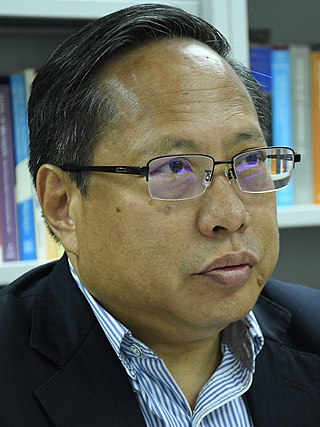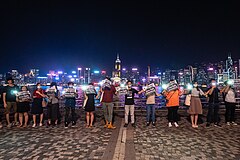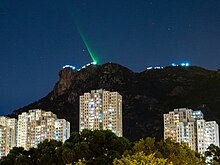
The Mass Transit Railway (MTR) is a major public transport network serving Hong Kong. Operated by the MTR Corporation (MTRCL), it consists of heavy rail, light rail, and feeder bus services, centred around a 10-line rapid transit network, serving the urbanised areas of Hong Kong Island, Kowloon, and the New Territories. The system encompasses 245.3 km (152.4 mi) of railways, as of December 2022, with 179 stations—including 99 heavy rail stations, 68 light rail stops and 1 high-speed rail terminus.

Prince Edward is a station of the MTR rapid transit system in Hong Kong. It is located in Mong Kok, Kowloon, under the intersection of Nathan Road and Prince Edward Road West, after which it is named.

The Baltic Way or Baltic Chain was a peaceful political demonstration that occurred on 23 August 1989. Approximately two million people joined their hands to form a human chain spanning 690 kilometres (430 mi) across the three Baltic states of Estonia, Latvia and Lithuania, which at the time were occupied and annexed by the USSR and had a combined population of approximately eight million. The central government in Moscow considered the three Baltic countries constituent republics of the Soviet Union.

Albert Ho Chun-yan is a solicitor and politician in Hong Kong. He is the former chairman (2014–2019) and vice-chair (2019–2021) of the Hong Kong Alliance in Support of Patriotic Democratic Movements of China, and former chairman of the Democratic Party from 2006 to 2012. He is a solicitor and a former member of the Legislative Council of Hong Kong for District Council (Second) constituency.

The pro-Beijing camp, pro-establishment camp or pro-China camp is a political alignment in Hong Kong which generally supports the policies of the Beijing central government and the Chinese Communist Party (CCP) towards Hong Kong. The term "pro-establishment camp" is regularly in use to label the broader segment of the Hong Kong political arena which has the closer relationship with the establishment, namely the governments of the People's Republic of China (PRC) and the Hong Kong Special Administrative Region (HKSAR). Pro-Beijing politicians are labeled "patriots" by pro-Beijing media and "loyalists" by the rival pro-democracy camp.

The 2019 Hong Kong District Council elections were held on 24 November 2019 for all 18 District Councils of Hong Kong. 452 seats from all directly elected constituencies, out of the 479 seats in total, were contested. Nearly three million people voted, equivalent to 71 per cent of registered voters, an unprecedented turnout in the electoral history of Hong Kong. The election was widely viewed as a de facto referendum on the concurrent anti-extradition protests.

The 2019–2020 Hong Kong protests were a series of demonstrations against the Hong Kong government's introduction of a bill to amend the Fugitive Offenders Ordinance in regard to extradition. It was the largest series of demonstrations in the history of Hong Kong.

The 2019 Yuen Long attack, also known as the 721 incident, refers to a mob attack that occurred in Yuen Long, a town in the New Territories of Hong Kong, on the evening of 21 July 2019. It took place in the context of the 2019–2020 Hong Kong protests. A mob dressed in white stormed the MTR's Yuen Long station and attacked protesters returning from a demonstration in Sheung Wan on Hong Kong Island as well as bystanders.

The period from March to June 2019 in the 2019–2020 Hong Kong protests is considered the early stage of the movement. Until the first mass demonstrations in June, protests were focused on the withdrawal of the extradition bill. In June, protesters started to lay out five demands. The additional four demands concerned the reactions of the Hong Kong government and especially, the police to the protests, and called more broadly for full democracy in the city.

This segment of the timeline of the 2019–2020 Hong Kong protests covers the month of July 2019. The anniversary of the 1997 handover of Hong Kong to China on 1 July saw large daytime protests. In the evening of that day, protesters stormed the Legislative Council Building and defaced symbols, with police only moving in after midnight. This incident, which was sharply condemned by the government of Carrie Lam, did however not lead to a split between peaceful and violent protesters. Observers linked the understanding of the non-violent protesters for the violent wing to the lack of willingness of the Lam government to engage in dialogue about the protesters' five demands. Apart from major protests on Sundays, there were also mostly peaceful demonstrations during the week.

The month of August 2019 in the 2019–2020 Hong Kong protests saw a continuation of protests throughout the city. Several of the peaceful daytime protests were held by social groups such as families, the elderly, and various professions. In many instances, peaceful protests occurs during the day, turning increasingly violent at night. In North Point and Tsuen Wan, white- or blue-shirted armed groups were attacking protesters, but unlike in the Yuen Long violence of 21 July they were beaten back in North Point. Protesters aimed at drawing international attention through methods such as extended sit-ins at the airport. In many occasions, an eye injury of a female protester who had served as frontline medical staff became a symbol of the protests. At the airport protests, a mainland journalist was violently tackled by protesters who did not reveal his identity to the protesters. Protesters later apologised for this incident, reducing tensions and satisfying some pro-establishment lawmakers. The Prince Edward station attack on 31 August proved to be a further landmark event in the protests.

The sophistication, novelty and diversity of tactics and methods used by protests in the 2019–2020 Hong Kong protests have been noted by many scholars and news outlets around the world. They range from new principles of autonomy and decentralisation, incorporating different methods of demonstration, economic and social protest, and most notably new technological methods for organising and ensuring the security of protesters. Many of these tactics have been used or were inspired by previous protests. The sheer scale, complexity, and variety of tactics used have become a case study for mass protests around the world. This article aims to present the most relevant tactics and methods used during the Hong Kong protests.

This is a list of domestic and international reactions to the 2019–2020 Hong Kong protests.

The month of September in the 2019–2020 Hong Kong protests saw again citywide unrest. Chief Executive Carrie Lam announced on 4 September that the extradition bill, in suspension since July, would be fully withdrawn, which fulfilled one of the five demands of the protesters. Also, following an earlier promise, Lam held a discussion session with randomly selected members of the public on 26 September. These acts, however, had little to no effect on the protests, as protesters insisted that all of the five demands be met. That this latter goal would be hard, if not impossible, to achieve – due to the very limited room given to Lam's administration by mainland Chinese authorities, as transpired from comments by officials – did not discourage the protesters from continuing to take to the streets.

Activists and artists taking part in the 2019–2020 Hong Kong protests used artwork, painting, music, and other forms of artistic expression as a tactic to help spread awareness about the events that have happened in the city. Individuals who create protest art are commonly referred to as the "publicity group" (文宣組). Creating protest art is seen as a peaceful, alternative way for citizens to express their views without participating in protests. Most members work under pseudonyms to protect their identity and stay in line with the movement's leaderless nature.

In October 2019, the 2019–2020 Hong Kong protests saw a further escalation of violence. It became evident that the protests were unlikely to end soon, and that they posed the biggest popular challenge to Chinese Communist Party (CCP) leader Xi Jinping since his ascension to CCP general secretary in 2012. To bring the situation under control, Chief Executive Carrie Lam invoked colonial-era powers to impose an anti-mask law, aimed at preventing protesters from hiding their identity. Observers considered the law, which came into force on 4 October, as a precedent for possible wider use of emergency powers at the expense of citizens' freedoms and in addition democratic rights, as they even saw the possibility of the upcoming District Council elections being cancelled based on the emergency law. The mask ban did, however, not achieve the desired effect, but rather proved a further focal point of protests. In November, the High Court ruled the mask ban to be unconstitutional, although in April 2020, an Appeal Court ruled that it was constitutional in the case of unlawful assemblies.

The month of November 2019 in the 2019–2020 Hong Kong protests started with protesting in malls and police getting into homes and malls to arrest protesters. The death of Chow Tsz-lok in Sheung Tak, Tseung Kwan O had led to more protests. In mid November, there were city-wide strikes which lasted for more than a week. Hong Kong Police officers fired tear gas in Chinese University of Hong Kong (CUHK), Hong Kong Polytechnic University (PolyU), and nearby areas. In late November, the District Council elections were held. The pro-democracy camp in conjunction with the localist groups got more than 80 per cent of the seats and gained control of 17 out of 18 District Councils.

After the rapid deterioration of the overall situation in the city in the course of the previous months of the 2019–2020 Hong Kong protests, a degree of calming of the protests occurred in December 2019. This was due to several factors. One was an initial expectation of the protesters and their supporters that the government would finally offer concessions on the Five Demands – apart from the withdrawn extradition bill – after the resounding defeat of the pro-establishment camp in the District Council Elections on 24 November, which had dealt a blow to government rhetoric about its public support. The mass protests on 8 December were largely an expression of dissatisfaction that these concessions had not been forthcoming. Another factor seen as responsible for the decrease in the size of the protests was that the arrests during the Siege of Polytechnic University had thinned the ranks of the protesters.

The month of June 2020 was the first anniversary of the 2019–2020 Hong Kong protests. The decision taken by the National People's Congress on national security legislation and the alleviation of the COVID-19 pandemic in Hong Kong led to a new series of protests and international responses. On 30 June, the Standing Committee of the National People's Congress passed the Hong Kong national security law which came into force the same day, leading to even more people protesting on 1 July.

The month of August 2020 in the 2019–2020 Hong Kong protests saw only sparse and relatively small protests, mainly due to the city going through a third wave of the COVID-19 pandemic and an outdoor gathering ban on groups of more than two people. As the impact of the Hong Kong National Security Law on the city became increasingly evident, and additionally in response to acts by representatives of the local and mainland governments throughout the protests, Western democracies continued to voice sharp criticism and implemented sanctions against China, with the United States imposing sanctions on 11 Hong Kong officials on 7 August. These developments supported the opinion expressed by former British Foreign Secretary Malcolm Rifkind in late June that the protests had morphed from a mostly local dispute into an international one.













